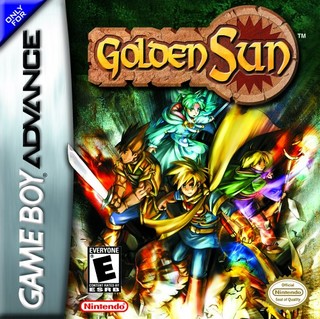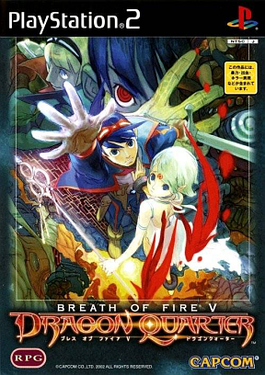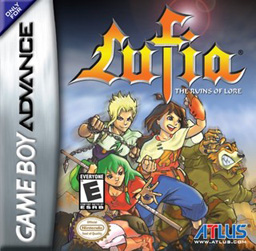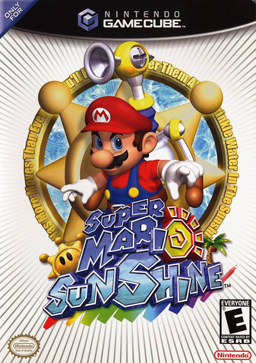
That title sucked.
But this game didn't. In a market where I thought RPGs were getting run into the ground with similar story elements and hackneyed mechanics, I found this beauty on the GBA.
Golden Sun is a unique game in its approach, handling, story -- well, anything, although the equipment system could be likened to other RPGs (I'll knife anyone who says the Djinn system is anything like Materia, though).
The land of Weyard once experienced a golden age of Alchemy -- that is, the power of the elements -- in which civilizations grew to incredible heights of achievement (amazing, an RPG that actually gives reasons for the existence of its ruins). However, the power of Alchemy lead to world conflict that eventually caused the desire to seal the power away to avoid its corruption. The powers of Alchemy (and in subsequent explanations, Psynergy) are divided into four elements represented through the game by Earth [Venus], Fire [Mars], Wind [Jupiter], and Water [Mercury]. I'm not quite sure why the chose those particular names for each element, but it seems to work for poetic effect. The power of Alchemy is harnessed by "adepts" of the given element, in the form of Psynergy -- essentially, magic in this game. The keys to Alchemy are 4 jewels each representing an aforementioned element, locking away the wellsprings of Alchemic power in the four elemental Lighthouses that the ancient cultures constructed throughout the world to house the power.
These jewels, the Elemental Stars (Mars Star, Jupiter Star, etc) are where our heroes enter the game. The jewels were hidden in Mt. Aleph, a mountain shrine that sits atop the town of Vale, which has been charged with protecting the jewels from those that would seek to unlock Alchemy again. Two of the main characters, Isaac and Garet, and a more minor story character in Jenna, hail from the village of Vale, along with the scholar Kraden. In the prologue, the village is attacked by two of the Mars tribe named Saturos and Menardi, in order to steal the elemental stars; however they failed to solve the puzzles of Mt. Aleph and were forced to flee. At the beginning of the game proper, they have returned with two accomplices -- one of which happens to be a former resident of Vale and Jenna's brother. Thus the plot thickens as Saturos and Menardi force you to hand over 3 of the 4 elemental stars before escaping the now pissed off Mt. Aleph with Jenna and Kraden as hostages to ensure you bring the fourth star to them.
The basic premise of the game is to travel to the lighthouses and stop them from being lit with the stars (thus freeing Alchemy once more, considered to be catastrophic now), and along the way you run into various problems in each town. They aren't quite as distracting as side quests and exposition usually are, and often give more background into the world. Along the way you meet your other party members, a Jupiter adept named Ivan and a Mercury adept named Mia, giving you a nice, well-rounded group.
The "gimmicks" of this game include the Psynergy you use to do damage in battle, heal, and solve puzzles with. The puzzle-solving aspect is the most interesting -- as you progress, you gain different psynergies that can open up other paths. For example, you initially start with "Move", which is just as it sounds. It extends a psycho-kinetic force that moves an object one space at a time. Further down the road you get other spells such as Force to knock down broken things or Frost to freeze puddles of water into pillars you can then hop on top of or push to switches. It's probably not -completely- innovative, but it feels new and fresh and adds a good spin on a genre that, admittedly, was feeling stale at the time. The other gimmick is the Djinn system. You have to collect little spirits of each element (the Djinn themselves), sometimes having to solve puzzles or battle them before they will join you. They can then be unleashed in battle after equipping them to yourself, causing various effects (critical attack, defense up, etcetera). After they've been unleashed, they can then be used to summon powerful creatures, but you lose the buffing to your stats without the Djinn equipped. After a summon, the djinn need to recharge and will automatically reequip themselves after recharging, forming a rather well-crafted battle flow. A third gimmick is weapon unleashing, which occurs with rare equipment -- essentially, it's a critical hit with added effects and nice visuals, such as lowering enemy's attack or causing paralysis.
Another interesting part is the artifact system, in which you find or are able to buy valuable strong equipment. Should you sell them, you can buy them again at a raised price from any weapon or armor dealer in the world.
The difficulty curve jumps around a lot throughout the game, but it's at understandable intervals. The dungeons (like the Lighthouses) are long, but feel like you're accomplishing stuff along the way.
However, when you reach the end, you'll be wondering "what, that's it?" The game itself seems unfinished, but it leads to an incredible sequel that juxtaposes everything you learn in this game. Essentially, each game is half of the full story, and the writers at Camelot showed incredible vision in how they planned out everything that occurred in both games.
The only major complaint I could have would be the nonbattle artwork. The 3D rendered models are cute, but I think it could have been more successful as 2D sprites. The 3D effect makes characters and enemies look pixelated and choppy, whereas a much smoother effect could be more effectively utilized with 2D. Although, since the world itself is rendered in isometric 3D, it does work reasonably well.
All in all, this game is an amazing RPG that I was happy to see featured in SSBB, although I wish they had made one of the heroes of the series a character instead of an assist trophy. This series is a gem for the GBA, and a favorite of mine on par with many Final Fantasy games with longer stories and better graphics. I think that really speaks to Camelot's ability as creators. Unfortunately, the series seemed to have a great deal of closure at the end of the second game, which leads me to believe there's little chance of a third Golden Sun.
Regardless, give the series a try. If you like RPGs with a puzzle twist, you won't be dissapointed.






